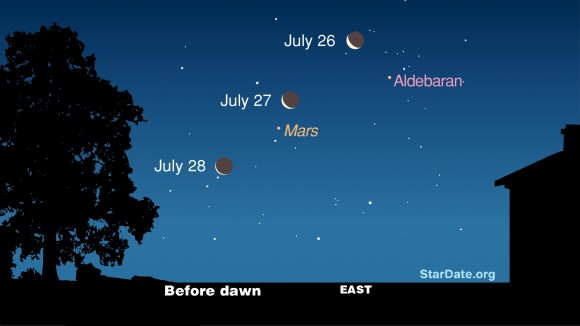Be on morning alert from July 26 through July 28 as the Moon, Mars and Aldebaran put on a delightful sky show that doesn’t require any special equipment – just cooperative weather! While this motion picture doesn’t have any sound, what it will have is color to delight the eye.
 When it comes to viewing the night sky, most people don’t perceive much color. Things mostly appear black and white – with a little gray on the Moon thrown in for good measure. With experience, most skywatchers easily pick out blue stars and faded green in nebula, but what really gets our hearts ticking is red. And very few stars show that ruddy hue to unaided vision as well as the eye of Taurus the Bull – Aldebaran.
When it comes to viewing the night sky, most people don’t perceive much color. Things mostly appear black and white – with a little gray on the Moon thrown in for good measure. With experience, most skywatchers easily pick out blue stars and faded green in nebula, but what really gets our hearts ticking is red. And very few stars show that ruddy hue to unaided vision as well as the eye of Taurus the Bull – Aldebaran.
The Astronomical Research Center (A.R.C) mentioned that on the morning of July 26th, about an hour before dawn, the waning crescent Moon will be very close to Alpha Tauri and the contrast will make for a spectacular showing. The following morning, it will hover just above Mars and slide into position just below on July 27th. Take the time to really look at what you’re seeing. Of the three principle players, the only one that generates its own light is Aldebaran… the rest are products of reflection. While the star’s russet tone comes from being a cool giant, Mars’ color comes from iron oxide. Not only is the Moon reflecting back sunlight, but you’ll also see the DaVinci effect where the “dark side” is gently illuminated as well.
Don’t be surprised if folks you know ask you what’s going on. Close conjunctions such as this excites the eye! Why? When it comes to our eyes, almost every photoreceptor has one ganglion cell receiving data in the fovea. That means there’s almost no data loss and the absence of blood vessels in the area means almost no loss of light either. There is direct passage to our receptors – an amazing 50% of the visual cortex in the brain! Since the fovea doesn’t have rods, it isn’t sensitive to dim lights. That’s another reason why the conjunctions are more attractive than the surrounding starfields. Astronomers know a lot about the fovea for a good reason: it’s why we learn to use averted vision.